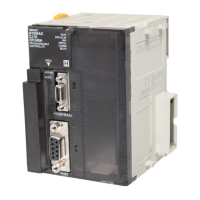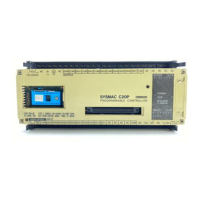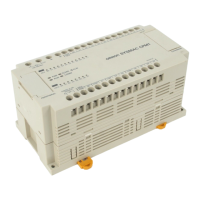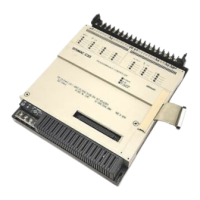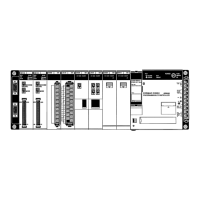6
7
500.00
PT
FALS
PT
I/O bus error
Error in Special I/O
Unit
Floating-
point
decimal
Character
string
Conversion instruction
E.g., 500.00 353030E23030
Character-string
display element
Serial
communications
Measurement device
(example)
Floating-
point
decimal
Character
string
Conversion instruction
PIDAT
Autotuning for PID constants
PID control instruction with
autotuning
D00000
#0000
OUTB
a
a
a
a
With CS1-series PLCsWith other PLCs
ORW
D00000
#0001
D00000
ANDW
D00000
#FFFE
D00000
FAL
PT
(Example)
Floating-point
decimal instruction
High-precision positioning
Equipped with functions demanded by the production site to
suit a variety of applications.
The evolution of
the SYSMAC CS1 is
accelerating advances in
the production site.
Convert Between Floating-point Decimal and Character Strings
The new CS1 can convert floating-point
decimal (real numbers) to character
strings (ASCII) for display on a PT
(operator interface). The data can be
displayed on the PT as a character-
string display element.
The new CS1 can convert ASCII
character strings read from
measurement devices by serial
communications to floating-point
decimal data for use in data processing.
Highly Accurate Positioning
with XY Tables
The new CS1 has many double-
precision processing instructions for
floating-point decimal operations,
enabling positioning with greater
accuracy.
Error Status Generation for
Debugging
PID Autotuning
The new CS1 can autotune PID
constants with a PID control instruction.
The limit cycle method is used for
autotuning, so the tuning is completed
quickly. This is particularly effective for
multiple-loop PID control.
Simpler Ladder Programs
Ladder programs that use a lot of basic
instructions can be simplified using
differentiation instructions LD NOT,
AND NOT, and OR NOT, and
instructions that access bits in the DM
and EM Areas.
A specified error status can be
simulated by executing the diagnostic
instructions (FAL/FALS). With the new
CS1, debugging is simple for
applications that display messages on a
PT or other display device based on the
error status of the CPU Unit.
Easy Reading of Maintenance
Data via DeviceNet
(for CPU Unit Ver. 2.0 or Later)
Nested Interlocks (for CPU Unit Ver. 2.0 or Later)
The addition of special explicit message
instructions makes it easy to send
explicit messages without having to
consider FINS commands. Transferring
data among PLCs with explicit
messages is also simplified.
Although strictly speaking the present
interlock instructions do not allow
nesting, applications can be created to
include combination of complete and
partial interlock conditions that achieve
nested interlocks.
Binary Set Values for
Timer/Counter Instructions
The SV for a timer or counter
instruction can be specified using either
BCD or binary. Using binary SV enables
longer timers and higher-value
counters.
An error has
occurred at unit
number xx.
There is a
possibility that
rack number xx
is disconnected.
Examples: Timer/Counter Instructions
TIM (BCD): 0 to 999.0 s
TIMX(550) (binary) 0 to 6553.5 s
CNT (BCD): 0 to 999 counts
CNTX(546) (binary) 0 to 65,535 counts
Applicable Timer/Counter Instructions
TIMER: TIMX(550)
COUNTER: CNTX(546)
HIGH-SPEED TIMER: TIMHX(551)
ONE-MS TIMER: TMHHX(552)
ACCUMULATIVE TIMER: TTIMX(555)
LONG TIMER: TIMLX(553)
MULTI-OUTPUT TIMER: MTIMX(554)
REVERSIBLE COUNTER: CNTRX(548)
RESET TIMER/COUNTER: CNRX(547)
Special explicit
message instruction
No need to
consider FINS
DeviceNet
TIME-PROPORTIONAL
OUTPUT (TPO) Instruction
(for CPU Unit Ver. 2.0 or Later)
=
DT
Time-proportioning PID
control can be handled
by the PLC by combining
the PID and TPO
(TIME-PROPORTIONAL
OUTPUT) instructions.
PID
S
C
D
TPO
S
C
B
SSR
Emergency
stop button
Product added
by contact a
Contact a
Operator
Emergency
stop button
MILH 0
MILC 1
MILH 1
MILC 0
Conveyor
operates
Product
added
Worker present (a)
CX-Programmer Screen
Support Software
clearly shows the
interlock status.
Compared using
BCMP2 instruction
The time interval
for execution by
the GRY
instruction is
determined by the
response speed
for reading data
from the absolute
encoder.
Absolute
encoder
Parallel
wiring
GRY
BCMP2
ON
OFF
OFF
ON
OFF
Upper limit Lower limit
Comparison table Output
Angular data
Value
converted by
GRY
instruction
Cam switch
Easy Cam Switch Control with Ladder Instructions
(for CPU Unit Ver. 2.0 or Later)
Easy Calendar Timer Function
(for CPU Unit Ver. 2.0 or Later)
Turn ON at 5:00
every evening
Compares two
dates/times Comparison
can be limited to any
combination of years,
months, days, hours,
minutes, or seconds.
Example:
A calendar timer function
can be easily set up to
start a process at exactly
5:00 every evening.
20 % 80 %
1 s
(1) Conveyor operates
(2) Contact "a" turns ON when operator is present and
products are supplied.
(3) When the emergency stop button is pressed, the
conveyor and product addition both stop.
Gray code converted
into binary, BCD, or
angles.
Compared to see whether
data is between upper
and lower limits.
Manipulated variable

